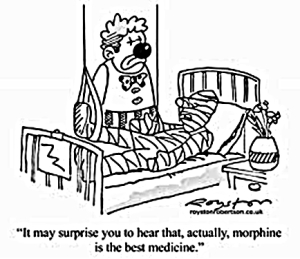DEA Bullying Denies Relief to Those With Chronic Pain
Posted by Bob Aronson
By Bob Aronson
I suffer from Chronic Pain and do millions of others and it’s getting more and more difficult to get any relief from it because two federal agencies are bullying physicians.
My neck and shoulder pain started after my heart transplant and some of it was directly related to the position of my arms while I was in surgery. Many transplant recipients suffer the same fate, but transplant or not if a person is in pain relief should be no farther away than your doctor’s office. It’s not!
I have received dozens of messages from pain sufferers since I published the previous two posts on the subject of chronic pain and physicians who simply will not prescribe narcotics (1. Why You Can’t Get Pain Meds http://tinyurl.com/knltszh and (2. Suffering from Chronic Pain? Here’s what you need to know http://tinyurl.com/lzy8o22 and that’s what prompted me to write this third blog on the subject. I’m angry, frustrated and helpless.
The U.S. Drug Enforcement Administration (DEA) mission (more on that later) is essentially to stop the production and sale of illegal drugs in America. Their “War on Drugs” is well known and it has recently expanded from the poppy fields to the practice of medicine and to pharmacies.
is essentially to stop the production and sale of illegal drugs in America. Their “War on Drugs” is well known and it has recently expanded from the poppy fields to the practice of medicine and to pharmacies.
A few years ago Florida was the state of the “Pill Mills,” places where almost anyone could get powerful prescription pain killers just by showing up at the Doctor’s office. So flagrant were the violations that the DEA had a  heyday of arrests and convictions but like many federal agencies they didn’t know when to stop. Not satisfied with putting the “Pill Mill” docs out of business, they turned to the regular physicians and warned them of investigations and loss of license if they were found to be prescribing narcotic pain meds to people who weren’t in pain.
heyday of arrests and convictions but like many federal agencies they didn’t know when to stop. Not satisfied with putting the “Pill Mill” docs out of business, they turned to the regular physicians and warned them of investigations and loss of license if they were found to be prescribing narcotic pain meds to people who weren’t in pain.
Many physicians who saw the DEA overreaction to the “Pill Mills” overreacted themselves and decided not to prescribe opioids (narcotics or controlled substances) to anyone. The result is that many who suffer from chronic pain that cannot be relieved by anything other than narcotics can’t get them and are suffering needlessly.
How chilling is the DEA’s action. Try this on for size. 44% of American doctors confess that a fear of a police or DEA investigation into their practice influenced the way that they prescribed medications to chronic pain patients. This according to a poll of doctors for the Center for Addiction and Substance Abuse.
The DEA’s actions are harming patients and maybe it is because their mission is the most convoluted, overly broad, confusing detailed mess you’ll ever see.
Here are three of examples of Mission Statement excellence
- TED: Spreading Ideas. (2 words)
- Smithsonian: The increase and diffusion of knowledge. (6 words)
- USO lifts the spirits of America’s troops and their families. (9 words)
- DEA (347 words)
(This is only part of it you can see the rest at http://www.justice.gov/dea/about/mission.shtml)
The mission of the Drug Enforcement Administration (DEA) is to enforce the controlled substances laws and regulations of the United States and bring to the criminal and civil justice system of the United States, or any other competent jurisdiction, those organizations and principal members of organizations, involved in the g rowing, manufacture, or distribution of controlled substances appearing in or destined for illicit traffic in the United States; and to recommend and support non-enforcement programs aimed at reducing the availability of illicit controlled substances on the domestic and international markets.
rowing, manufacture, or distribution of controlled substances appearing in or destined for illicit traffic in the United States; and to recommend and support non-enforcement programs aimed at reducing the availability of illicit controlled substances on the domestic and international markets.
They wrote a mission statement that sets them up to invade anyone at any time for any reason. If they were legitimately concerned with stopping the flow of illegal drugs their mission statement probably could have said. “The Mission of the DEA is to stop the production and sale of illegal drugs in the United States” (19 words). Instead, they chose to write a book that gives them the authority to assume more authority.
Essentially what the DEA is talking about is Opioids so let’s start with a definition.  What is an Opioid? According to the National Institute on Drug Abuse opioids are medications that relieve pain. They reduce the intensity of pain signals reaching the brain and affect those brain areas controlling emotion, which diminishes the effects of a painful stimulus.
What is an Opioid? According to the National Institute on Drug Abuse opioids are medications that relieve pain. They reduce the intensity of pain signals reaching the brain and affect those brain areas controlling emotion, which diminishes the effects of a painful stimulus.
Medications that fall within this class include hydrocodone (e.g., Vicodin), oxycodone (e.g., Oxycontin, Percocet), morphine (e.g., Kadian, Avinza), codeine, and related drugs. Hydrocodone products are the most commonly prescribed for a variety of painful conditions, including dental and injury-related pain. Morphine is often used before and after surgical procedures to alleviate severe pain. Codeine, on the other hand, is often prescribed for mild pain. In addition to their pain relieving properties, some of these drugs—codeine and diphenoxylate (Lomotil) for example—can be used to relieve coughs and severe diarrhea.
 In their zeal to accomplish the impossible mission the DEA has now ventured into the practice of medicine a discipline for which they are not qualified nor are they welcome. As a result, thousands upon thousands of Americans are suffering incredible pain. They can’t get relief because their physicians have been intimidated by the DEA and to a lesser degree the Food and Drug Administration (FDA). We have here a sort of medical paradox, the feds want to practice medicine and the medical doctors are afraid to.
In their zeal to accomplish the impossible mission the DEA has now ventured into the practice of medicine a discipline for which they are not qualified nor are they welcome. As a result, thousands upon thousands of Americans are suffering incredible pain. They can’t get relief because their physicians have been intimidated by the DEA and to a lesser degree the Food and Drug Administration (FDA). We have here a sort of medical paradox, the feds want to practice medicine and the medical doctors are afraid to.
This report from the Reuters news agency pretty much sums up the way many physicians are reacting to DEA’s bullying: “Many physicians have increased patient monitoring, which means more urine tests, more documentation, and more frequent “pill count” checks, where patients must go to the prescriber’s office with their pill bottles to prove they have not sold or misused their medication.
“Every hour of the day I have concerns I’ll be audited, that my ability to take care of my patients and my family can be taken away, and I’m as legitimate as you can get,” said one  prescriber who has a private orthopedic practice in Florida. “You’re constantly watching over your shoulder and it takes a toll,” he told Reuters news.
prescriber who has a private orthopedic practice in Florida. “You’re constantly watching over your shoulder and it takes a toll,” he told Reuters news.
Safety and security are one thing but when a law enforcement agency decides to run rampant over a legitimate segment of the private sector, someone, somewhere ought to stand up and take notice.
In their long but terribly unsuccessful effort to control illegal drugs the DEA has now focused their attention on prescription drugs and in particular those few physicians (most of them were in Florida) who wrote narcotics prescriptions for nearly anyone who wanted them. And…they’ve been successful. Most of the pill mills are gone, b ut the DEA is like a runaway Abrams tank and is now rumbling over the medical profession.
ut the DEA is like a runaway Abrams tank and is now rumbling over the medical profession.
In typical federal overreaction to the “Pill Mill” crisis, the DEA decided to crack down on all physicians by letting them know that they were being watched and that they had better be damned sure they were prescribing narcotics for real pain and not to junkies.
The overreaction by the Feds was met by an equal overreaction by many physicians. They just quit prescribing opioid (narcotic) pain meds because they don’t want the hassle. Both the feds and the docs seem to have forgotten us patients. We are the ones who get the short, sharp, infected end of the stick.
Not satisfied with their efforts, but impressed with their nearly effortless intimidation of the medical profession the DEA then decided that while they concentrated on powerful narcotics like oxycontin and oxycodone the effort should not stop there. They also  wanted restrictions on a lower level of painkillers as well so they crossed the street and bullied the FDA into telling docs they had better be careful when they prescribe Vicodin and Lortabs. Both contain hydrocodone and are usually combined with over the counter analgesics like aspirin or Tylenol.
wanted restrictions on a lower level of painkillers as well so they crossed the street and bullied the FDA into telling docs they had better be careful when they prescribe Vicodin and Lortabs. Both contain hydrocodone and are usually combined with over the counter analgesics like aspirin or Tylenol.
The result? If you suffer from chronic pain you are going to have a very difficult time getting any drug containing a narcotic or other controlled substance. The medical profession has been scared to cause many docs to refuse to prescribe narcotics or any other controlled substance including drugs like Valium which is non-narcotic but still a controlled substance.
Many so-called “Pain Clinics” will not prescribe narcotics at all for any reason. Instead they will look for “root causes” and try a raft of anti-inflammatory and other treatments. And, to be fair, in some cases those “other treatments” work, but while the pain experts are searching for non-opioid solutions, the patient suffers. I know I’m one of them. When I asked one pain clinic doc for narcotics after repeated failed attempts to control my pain he said,”I can’t do that, see your primary.” The “can’t” part of the answer is pure BS. Won’t is the correct word to use — won’t because he has been intimidated by the feds. I endured weeks of agonizing, debilitating pain because they refused to prescribe narcotics even though nothing else was working.
There are some docs who have the courage to practice medicine despite the fact that two powerful federal agencies are threatening them with a minimum of being investigated and a maximum of license revocation. Physicians feel as though they are constantly being watched.
fact that two powerful federal agencies are threatening them with a minimum of being investigated and a maximum of license revocation. Physicians feel as though they are constantly being watched.
My primary care doc understands that I really do suffer from chronic pain and that I have tried other approaches that have failed. Despite that, to protect his license he monitors my use of the Oxycodone he prescribes very carefully. He requires that once a month, when it is time for a prescription refill he sees me in his office where he reviews my case, questions me about my pain level and then reminds me of the dangers of opioids even though I have never sought an increase in dosage and am not an addict..
I still believe that while the DEA and the FDA are being heavy handed, physicians who are licensed to practice medicine and fail to prescribe drugs that have been proven to be effective must bear some of the responsibility for the suffering many chronic pain patients are experiencing.
 Reminiscent of so many tyrannical regimes the DEA absolves itself of any responsibility for the suffering they have caused among patients with chronic pain. Here’s what they told The National Pain Report.
Reminiscent of so many tyrannical regimes the DEA absolves itself of any responsibility for the suffering they have caused among patients with chronic pain. Here’s what they told The National Pain Report.
“The agency is not trying to limit access to opioid painkillers. And if legitimate pain medication prescriptions are not being written or filled, it’s the fault of doctors and pharmacists, not the government,” said DEA spokesman Rusty Payne.
“We’re not doctors. We’re regulators and enforcers of the law. If something is prescribed for a legitimate medical purpose, we’re certainly not going to get in the way. If a pharmacy chooses not to fill a prescription for someone, that’s their decision. It’s not the DEA’s decision,” he said.
To me that’s a whole lot like a cop stopping you for no good reason, warning you about speeding and then telling you that he and other cops are watching you very carefully to be sure you abide by all the rules. Then, if due to fear you just quit driving they say, “That was his choice, we didn’t tell him to stop driving.”
So our bottom line is this. If you have chronic pain and all the non-narcotic remedies don’t work you are going to have to grin and bear it for a while. No physician in this environment is going to write opioid prescription for someone who walks in from the street complaining of pain. You are going to have to prove it. Your chances of getting relief maybe better from your primary care physician but bring evidence of your pain
- X-rays, MRIs, CT scans
- Written diagnosis, prognosis, treatment and instructions from other physicians or emergency departments
- Prescription records
- Police or other reports if you’ve had an injury
- Reports from physical therapists or Chiropractors
- Anything else that will help prove your claim that you have chronic pain and that opioids may be your only relief.
If you want a primary care physician to help you, it is going to take a little time to build a relationship and he or she may even want you to repeat some tests you have already undergone. Be prepared to hurt for a while because it is unlikely that any physician you have not seen before will prescribe a narcotic pain killer after only one or two appointments. That’s what our friends at DEA have done for us.
If all of this really gets under your skin, call, write, email, text, holler at or visit your Congressional Representative, Your Senator and/or The President of the United States.
-0-
 Bob Aronson is a 2007 heart transplant recipient, the founder and primary author of the blogs on this site and the founder of Facebook’s over 3,000 member Organ Transplant Initiative group.
Bob Aronson is a 2007 heart transplant recipient, the founder and primary author of the blogs on this site and the founder of Facebook’s over 3,000 member Organ Transplant Initiative group.
Now retired and living in Jacksonville, Florida with his wife Robin he spends his time advocating for patients with end stage diseases and for organ recipients. He is also active in helping his wife with her art business at art festivals and on her Rockin Robin Prints site on Etsy.
Bob is a former journalist, Governor’s Communication Director and international communications consultant.
About Bob Aronson
Bob Aronson is a former journalist, a Minnesota Governor's Press Secretary and talk show host. For nearly a quarter of a century, he led the Aronson Partnership, a Minnesota-based communications consultancy that prepared corporate and government executives for crisis situations, regulatory testimony, media interviews and Presentations. Among his clients were all three U.S. Mayo Clinic locations, 3M, general Mills, CH2M Hill, the U.S. Department of Energy and scores more. In 2007 bob had a heart transplant after suffering from idiopathic dilated cardiomyopathy for 12 years. Shortly after he got his new heart he founded the now 4,300 member Facebook support group, Organ Transplant Initiative. At the same time, he established the Bob's Newheart blog where he has posted nearly 300 columns on organ donation, transplantation and other health related issues. The Viewpoint blog was started in late 2016 and bears the name of the Radio Talk show Bob did from 1966 until 1974, when he resigned to become Minnesota Governor Rudy Perpich first Press secretary. Bob and his artist wife Robin, live in Jacksonville, Florida with their two dogs, Reilly and Ziggy. Bob is also a woodworker and makes all of the furnishings for Robin's art festival booth. He also makes one of a kind jewelry or "memories" boxes that he donates to select transplant patients, caregivers, donor families and others who have somehow contributed to making life easier for the ill, the elderly and the less fortunate. Bob is in the final stages of editing two full-length novels that will be available on Kindle when ready for release sometime in early 2017. One is a sci fi novel about an amazing discovery near Roswell, New Mexico and you will be surprised to find it has nothing to do with the Roswell story everyone knows. It features a woman scientist who investigates impact craters for the U.S. Department of the Interior, Dr. Rita Sylvester and her female student intern. The other book is a political thriller that introduces a new hero to the genre, Fargo Dennison.Posted on March 8, 2014, in Pain and tagged bullying, DEA, FDA, intimidation, lortab, opioids, oxycodone, oxycontin, pain clinics, physicians, pill mills, primare care physician, v, Valium, Vicodin. Bookmark the permalink. 1 Comment.

You are absolutely right about the bullying of the DEA. My doctor has to jump through hoops and will continue to do so as long as he can because he believe it’s his responsibility to do so. Only a few Pharmacies will fill his scripts because they to have been bullied but they have clean records so they fill the prescriptions. So the DEA threatens the distributors and Manufactures not to sell to them. People are having to turn to illegal means to help with the pain, which helps keep the DEA in business. What can we do to stop this?
LikeLike